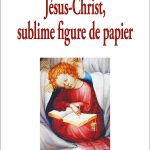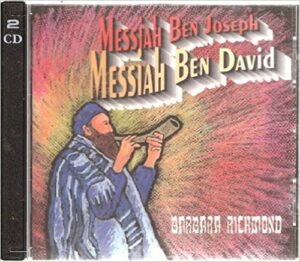 Continuing the series Charbonnel: Jesus Christ sublime figure de papier . . .
Continuing the series Charbonnel: Jesus Christ sublime figure de papier . . .
A Messiah to combine the different messianic visions
Nanine Charbonnel [NC] has been exploring various ways the Jesus figure of the gospels was drawn to embody certain groups of people and now proceeds to discuss the way our evangelists (gospel authors) also found ways to encapsulate the different Jewish ideas about the Messiah into him as well. I have posted many times on Second Temple messianic ideas and questioned a common view that there was “a rash of messianic hopes” in first-century Palestine. I post links to some of these posts that illustrate or expand on NC’s points.
Various Messiahs
Vridar posts on Second Temple Messiahs
Here are some tags linking to the posts. (As you can see, there is some overlap here that needs to be tidied up but this is the state of play at the moment):
Dying messiah 5 posts
Jewish Messianism 11 posts
Messiah 17 posts
Messiahs 11 posts
Messianic Judaism 2 posts
Messianism 15 posts
Second Temple messianism 41 posts
And a catch-all category
Messiahs and messianism 95 posts
NC lists different views of the messiah as listed by Armand Abécassis (En vérité je vous le dis):
- the messiah would be a priest (said to be “the Sadducee” view — though I cannot vouch for all of these associations)
- the messiah would be a royal heir of David (said to be “the Pharisee” view)
- the messiah would be a scribe descended from Aaron (said to be an Essene view)
- the messiah was related to a kind of baptist or purification movement (said to be the Boethussian view)
Among the texts of the Dead Sea Scrolls are found at least three different types of messiah
1. the royal messiah, the branch or offspring of David, who is accompanied by a prophetic figure who is an interpreter of the law
2. the priestly messiah, an ideal priest from the line of Aaron
In some scrolls these two messiahs appear together. They are perhaps the idealistic corrective to historical kings and priests who were considered corrupt.
3. a “Son of God” figure, “probably a unique celestial figure”, appears to be divine, without a name assigned although in other manuscripts he is given the name Melchisedech, the agent of divine judgment against evil.
André Paul (whom NC is quoting) concludes that these three messianic figures were part of Jewish thinking in the century or century and a half preceding the time of Jesus of Nazareth.
Pre-Christian Jewish thought about these three different messiahs drew upon Scriptures to flesh out what they were to accomplish. The promise Nathan made to David in 2 Samuel 7 that his throne would endure “forever”, and the prophecy in Isaiah 11:1-5 that a “branch will arise from the stump of Jesse”, and that of Isaiah 61:1 that “he will heal the wounded and revive the dead and proclaim the good news and invite the hungry to feast”, and many others, were applied to their respective messiahs.
One striking example outside the biblical texts is found in the Messianic Apocalypse of the Dead Sea Scrolls. To translate Andre Paul’s observation (quoted by NC):
We are struck by the astonishing relationship between this description of future blessings linked to the coming of the Messiah and Jesus ‘answer to John the Baptist’s question in the Gospels:’ “The blind see, the lame walk ” (Matthew 11, 5 and Luke 7, 22). […] A tradition identifiable in other writings of ancient Judaism serves as their common basis.
The gospel authors were doing what Jewish writers before them had done. They were creating their messiah by pastiching different passages from the Scriptures. The gospels were even copying or incorporating the works of earlier exegetes as we see in the example of the Messianic Apocalypse.
It is these three types of messiah that “Christianity” will unite: Mashiach-Christos, High Priest (in particular in the Epistle to the Hebrews), and Son of Man. It has long been known that in the period of Christianity’s establishment there were struggles over the titles to be given to Jesus Christ. Can we not think that far from depending on different “legends”, the Gospels are midrashim voluntarily composed with a view to celebrating an existing messiah (existing in texts) to unite these divergent expectations? Those who call themselves the disciples of Jesus will make him at the same time the prophet, the priest and the king “thus cumulating all the functions of society and guaranteeing them” (Abécassis p. 290), aided in this by traditions already anchored in the Jewish society of the time.
(Charbonnel, 278, my translation with Google’s help)
We further have texts that have long been known to us, those we label pseudepigrapha. Among these are the Testaments of the Twelve Patriarchs. Some of these (the Testaments of Levi and Judah) speak of messianic variants: see TLevi ch2 and TJudah ch4.
NC next turns to biblical scholars questing for the historical Jesus and the significance they attach to the contexts of and emphases on different messianic allusions and sayings in the gospels — all in an effort to attempt to discern what Jesus may have thought about himself vis a vis what others (contemporaries, later generations) thought about him. But the whole exercise collapses when one approaches the gospel Jesus as a literary creation woven from the many messianic threads known to Second Temple Judaism.

Both the Messiah Son of David . . . .
The view that the messiah was to be a son of David is well understood: Isaiah 9:5-6; 11:1; Jeremiah 23:5-6; 30:9; etc …; Psalms of Solomon 17:21-43) — even if the details varied somewhat in the different writings. Matthew and Luke make Jesus a genealogical descendant of David; and whereas David was anointed with oil by Samuel Jesus was anointed directly by the Holy Spirit, and so forth.
NC takes us in for a closer look at what it means to be a “Davidic” figure.
First: the name David means Beloved. At Jesus’ baptism we are to hear a voice from heaven declaring Jesus to be God’s Beloved son (Matthew 3:17). (The name given for the Jesus figure in the Ascension of Isaiah is Beloved; further, see the series on Jon Levenson’s book The Death and Resurrection of the Beloved Son. There we learn that the “Beloved son” is virtually a technical term for an only or firstborn son who is destined for sacrifice. NC does not touch on this work, however.)
That Jesus was resurrected from the dead is another “Davidic” qualification given that a “Psalm of David” was interpreted by early Christians as a prophecy that “David” would not “be abandoned to Hades” — Acts 2:22-23.
(NC does not mention in this context other Davidic features of Jesus such as his ascent to the Mount of Olives in mourning for his life; his suffering of false and cruel persecutions by his former associates and family; his role as a meditative figure. See What might a Davidic Messiah have meant to early Christians?)
What NC does bring out, though, is the link with the nation of Israel itself being named by God as his Beloved. In the Septuagint we find Continue reading “Jesus embodies all the Jewish Messiahs — continuing Jésus-Christ, Sublime Figure de Papier”
